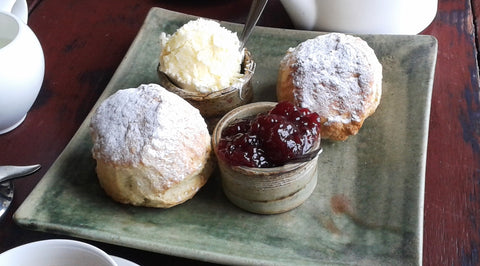A traditional cream tea is a speciality of Devon and Cornwall where a pot of tea is served with scones, jam and clotted cream. In this article we explain, what are the differences between a Cornish and Devon cream tea, where to find the best cream teas, how Devonshire and Cornish clotted cream differs and the history of the Cornish cream tea.

History of the Cornish Cream Tea
The exact origin of the "cream tea" is disputed, but Devonians claim there is evidence that the tradition of eating bread with cream and jam started at Tavistock Abbey in Devon in the 11th century. Afternoon tea started to become a popular tradition in 1840 when Anna, the 7th Duchess of Bedford, decided that she needed tea and a light snack to fill the gap between lunch and dinner. Initially, the Duchess’ afternoon teas consisted of a tray of tea, bread and butter and cake, rather than incorporating a cream tea. The cream tea started to become well known to the rest of the country in the early 1900s with the expansion of the railways.
Where to find cream teas
Cream teas are one of the biggest sellers for cafes and tearooms through Devon and Cornwall so as a result they’re available almost everywhere. Outside of Devon and Cornwall they can be found in some tearooms, particularly within neighbouring West Country counties Somerset and Dorset. They do make such an important part of an afternoon tea and as a result this is often the best way to indulge in a cream tea when visiting the West Country.
The best cream teas can usually be found in small shops, cafés, or private front rooms or gardens, where they are likely to be freshly made on the premises. Cafés, restaurants or coffee bars run by larger organisations are often unlikely to equal the cream teas available in small, family-run businesses.
Devon vs Cornish Cream Tea
The best way of serving a cream tea has long been the subject of fierce debate between Devon and Cornwall. Historically, there were a number of differences between the two counties cream teas, including the scones (with a traditional “Cornish split", a type of slightly sweet white bread roll, served in Cornwall) and the clotted cream used (see below). Nowadays, the main difference is the serving method. The Devonian method requires the eater to place the cream onto the half-scone first, almost as a replacement for butter or margarine. The Cornish method is the reverse, with the jam being positioned first and the cream applied as a second topping. Clearly we back the Cornish method and offer 10 light-hearted reasons for its superiority here. In a poll by the Guardian 57% of their readers voted in favour of the Cornish method. Some people have taken the debate rather seriously and even come up with scientific formula’s to settle the argument.
Cornish Clotted Cream
Clotted cream is a smooth, thick cream traditionally made in the West Country by heating unpasteurised cow's milk that is left in a shallow pan for many hours causing the cream to rise to the surface and 'clot'. Historically there were differences in the way clotted cream was produced in Devon and Cornwall with Cornish clotted cream produced through heating and Devonshire clotted cream through the old process of lapping the cream without heat. Nowadays, clotted cream in both counties is produced with modern machinery through either the ‘float’ or ‘scald’ cream techniques. In 1997 Cornish clotted cream was awarded ‘Protected Designation of Origin’ status, along with the likes of Champagne and Parma ham.
The Best Cornish Scones
You can’t beat fresh homemade scones, often indicated by a scones irregularity in shape. A good cream tea will include two healthy-sized scones, which should be split horizontally before applying the jam and cream. Scones look best with a good rise, one trick to achieving this is to use natural yogurt as an ingredient because its acidity helps the baking powder work better giving a good rise. As mentioned above, originally a Cornish Split formed the base of a proper Cornish cream tea. It’s more bread roll like than buttery scone. The Cream Tea Society offers a recipe for this traditional Cornish speciality.
 Over 5,000 5 Star Reviews
Over 5,000 5 Star Reviews
